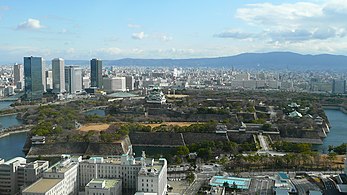
Osaka
Osaka (Japanese: 大阪市, Hepburn: Ōsaka-shi, pronounced [oːsakaɕi]; commonly just 大阪, Ōsaka [oːsaka] ⓘ) is a designated city in the Kansai region of Honshu in Japan, and one of the three major cities of Japan (Tokyo-Osaka-Nagoya). It is the capital of and most populous city in Osaka Prefecture, and the third-most populous city in Japan, following the special wards of Tokyo and Yokohama. With a population of 2.7 million in the 2020 census, it is also the largest component of the Keihanshin Metropolitan Area, which is the second-largest metropolitan area in Japan[4] and the 10th-largest urban area in the world with more than 19 million inhabitants.[3]
This article is about the city in Japan. For the prefecture with the same name where this city is located, see Osaka Prefecture. For other uses, see Osaka (disambiguation).
Osaka
大阪市
Japan
225.21 km2 (86.95 sq mi)
2,753,862
12,214/km2 (31,630/sq mi)
19,303,000 (2019, Keihanshin)
Osaka City Hall: 1-3-20 Nakanoshima, Kita-ku, Osaka-shi, Osaka-fu
530-8201
06-6208-8181
- 大阪
- (obsolete) 大坂
おおさか
オオサカ
Ōsaka
Ōsaka
Oosaka
Ōsaka was traditionally considered Japan's economic hub. By the Kofun period (300–538) it had developed into an important regional port, and in the 7th and 8th centuries, it served briefly as the imperial capital. Osaka continued to flourish during the Edo period (1603–1867) and became known as a center of Japanese culture. Following the Meiji Restoration, Osaka greatly expanded in size and underwent rapid industrialization. In 1889, Osaka was officially established as a municipality. The construction boom accelerated population growth throughout the following decades, and by the 1900s, Osaka was the industrial hub in the Meiji and Taishō periods. Osaka made noted contributions to redevelopment, urban planning and zoning standards in the postwar period, and the city developed rapidly as one of the major financial centers in the Keihanshin Metropolitan Area.
Osaka is a major financial center of Japan, and it is recognized as one of the most multicultural and cosmopolitan cities in Japan. The city is home to the Osaka Exchange as well as the headquarters of multinational electronics corporations such as Panasonic and Sharp. Osaka is an international center of research and development and is represented by several major universities, notably Osaka University, Osaka Metropolitan University, and Kansai University. Famous landmarks in the city include Osaka Castle, Osaka Aquarium Kaiyukan, Dōtonbori, Tsūtenkaku in Shinsekai, Tennōji Park, Abeno Harukas, Sumiyoshi Taisha Grand Shrine, and Shitennō-ji, one of the oldest Buddhist temples in Japan.
Etymology[edit]
Ōsaka means "large hill" or "large slope". It is unclear when this name gained prominence over Naniwa, but the oldest written evidence for the name dates back to 1496.[5][6]
By the Edo period, 大坂 (Ōsaka) and 大阪 (Ōsaka) were mixed use, and the writer Hamamatsu Utakuni, in his book Setsuyo Ochiboshu published in 1808, states that the kanji 坂 was abhorred because it "returns to the earth," and then 阪 was used. The kanji 土 (earth) is also similar to the word 士 (knight), and 反 means against, so 坂 can be understood as "samurai rebellion," then 阪 was official name in 1868 after the Meiji Restoration. The older kanji (坂) is still in very limited use, usually only in historical contexts. As an abbreviation, the modern kanji 阪 han refers to Osaka City or Osaka Prefecture.
Local administration
Toru Takahashi,
Shin Asakawa,
Tsuyoshi Yamamoto
Toshifumi Tagaya (LDP)
83 councilors (7 vacant)
Osaka Restoration Association (36),
Liberal Democratic Party
and Citizen's Club (20),
Komei Party (19),
Japanese Communist Party (9),
Go OSAKA (1)
Osaka Abe (1)
- Abeno-ku (4),
- Asahi-ku (4),
- Chūō-ku (2),
- Fukushima-ku (2),
- Higashinari-ku (3),
- Higashisumiyoshi-ku (5),
- Higashiyodogawa-ku (6),
- Hirano-ku (6),
- Ikuno-ku (5),
- Jōtō-ku (5),
- Kita-ku (3),
- Konohana-ku (3),
- Minato-ku (3),
- Miyakojima-ku (3),
- Naniwa-ku (2),
- Nishi-ku (2),
- Nishinari-ku (5),
- Nishiyodogawa-ku (3),
- Suminoe-ku (4),
- Sumiyoshi-ku (6),
- Taishō-ku (3),
- Tennōji-ku (2),
- Tsurumi-ku (3),
- Yodogawa-ku (5)






![Sakuranomiya Park [ja]](http://upload.wikimedia.org/wikipedia/commons/thumb/a/a5/Sakuranomiya-Park_02.jpg/293px-Sakuranomiya-Park_02.jpg)
